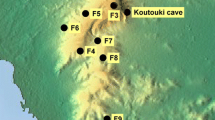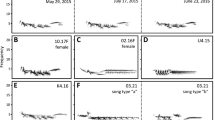Abstract
Songs of Orthoptera can be used for inventorying and monitoring of individual species and communities. Acoustic parameters such as carrier frequency and pulse rates allow the definition of recognizable taxonomic units (RTUs) which help to overcome the taxonomic impediment due to our scanty knowledge, particularly of tropical faunas. Bioacoustic diversity is a first estimate for species richness and provides baseline data which can be a prerequisite for conservation. Additional ecological and behavioural information such as habitat preference and singing schedules can be inferred. Many Orthoptera are sensitive indicator species for habitat quality in temperate and tropical ecosystems. Examples are given for evaluation of habitat quality and deterioration by acoustic detection of Orthoptera.
Similar content being viewed by others
References
Bailey, W.I. (1990) The ear of the bushcricket. In The Tettigonnidae: biology, systematics and evolution (W.J. Bailey and D.C.F. Rentz, eds), pp. 217–47. Berlin: Springer-Verlag.
Bellmann, H. (1993) Heuschrecken: Beobachten-Bestimmen. Augsburg: Naturbuch Verlag.
Bennet-Clark, H.C. (1987) The tuned singing burrow of mole crickets. J. Exp. Biol. 128, 383–409.
Bennet-Clark, H.C. (1989) Songs and the physics of sound production. In Cricket Behavior and Neurobiology (F. Huber, T.E. Moore and W. Loher, eds), pp. 227–61. Ithaca: Cornell University Press.
Binot, M., Bless, R., Boje, P., Gruttke, H. and Pretscher, P. (1998) Rote Liste gefährdeter Tiere Deutschlands. Bonn: Bundesamt für Naturschutz.
Chesmore, E.D., Feminella, O.P. and Swarbrick, M.D. (1998) Automated analysis of insect sounds using time-encoded signals and expert systems - a new method for species identification. In Information Technology, Plant Pathology and Biodiversity (P. Bridge, P. Jeffries, D.R. Morse and P.R. Scott, eds), pp. 273–87. Wallingford, UK: CAB International.
Elsner, N. (1994) The search for neural centers of cricket and grasshopper song. In Neural Basis of Behavioural Adaptations (K. Schildberger and N. Elsner, eds), pp. 167–93. Jena: Gustav Fischer Verlag.
Fischer, F.P., Schulz, U., Schubert, H., Knapp, P. and Schmöger, M. (1997) Quantitative assessment of grassland quality: acoustic determination of population sizes of orthopteran indicator species. Ecol. Appl. 7, 909–20.
Forrest, T.G. (1982) Acoustic communication and baffling behaviour of crickets. Florida Entomol. 65, 33–44.
Froehlich, C. and Holtzem, E. (1987) Bemerkenswerte Funde von Sichelschrecken (Phaneropterinae, Orthoptera, Tettigoniidae) mit neuer Methodik. Naturschutz und Ornithologie in Rheinland-Pfalz 4, 902–3.
Gaston, K.J. (1991) The magnitude of global insect species richness. Conserv. Biol. 5, 283–96.
Hawksworth, D.L. and Kalin-Arroyo, M.T. (1995) Magnitude and distribution of biodiversity. In Global Biodiversity Assessment (V.H. Heywood and R.T. Watson, eds), pp. 107–92. Cambridge, UK: Cambridge University Press.
Heller, K.G. and von Helversen, D. (1993) Calling behavior in bushcrickets of the genus Poecilimon with differing communication systems (Orthoptera: Tettigonioidea, Phaneropteridae). J. Insect Behav. 6, 361–77.
Heller, K.G. (1995) Acoustic signalling in Paleotropical bushcrickets (Orthoptera: Tettigonioidea: Pseudophyllidae): does predation pressure by eavesdropping enemies differ in the Paleo-and Neotropics? J Zool. 237, 469–85.
Huber, F., Moore, T.E. and Loher, W. (1989) Cricket Behavior and Neurobiology. Ithaca: Cornell University Press.
Ingrisch, S. (1997) Taxonomy, stridulation and development of Podoscirtinae from Thailand. Senckenbergiana Biologica 77, 47–75.
Kutsch, W. and Huber, F. (1989) Neural basis of song production. In Cricket Behavior and Neurobiology (F. Huber, T.E. Moore and W. Loher, eds), pp. 262–309. Ithaca: Cornell University Press.
Larsen, O.N., Kleindienst, H.-U. and Michelsen, A. (1989) Biophysical aspects of sound reception. In Cricket Behavior and Neurobiology (F. Huber, T.E. Moore and W. Loher, eds), pp. 364–90. Ithaca: Cornell University Press.
Lawton, J.H., Bignell, D.E., Bolton, B., Bloemers, G.F., Eggleton, P., Hammond, P.M., Hodda, M., Holt, R.D., Larsen, T.B., Mawdsley, N.A., Stork, N.E., Srivastava, D.S. and Watt, A.D. (1998) Biodiversity inventories, indicator taxa and effects of habitat modification in tropical forest. Nature 391, 72–75.
Mason, J.B. (1968) The tympanal organ of Acridomorpha (Orthoptera). EOS 44, 267–355.
Morris, G.K. and Beier, M. (1982) Song structure and description of some Costa Rican katydids (Orthoptera: Tettigoniidae). Trans. Am. Entomol. Soc. 108, 287–314.
Morris, G.K., Klimas, D.E. and Nickle, D.A. (1989) Acoustic signals and systematics of false-leaf katydids from Ecuador (Orthoptera, Tettigoniidae, Pseudophyllinae). Trans. Am. Entomol. Soc. 114, 215–264.
Nischk, F. (1998) Bioakustische Einnischung von Grillen (Orthoptera, Gryllidae): Ein Vergleich neotropischer Wald ökosysteme. Verhandlungen Westdeutscher Entomologentag 1997. Duesseldorf: Lobecke-Museum.
Otte, D. (1992) Evolution of cricket song. J Orthop. Res. 1, 25–44.
Otte, D. and Naskrecki, P. (1997) Orthoptera Species Online. hftp://viceroy.eeb.uconn.edu/Orthoptera (26/3/1998).
Pierce, G.W. (1948) The Songs of Insects. Cambridge, MA: Harvard University Press.
Ragge, D.R. and Reynolds, W.J. (1997) The Songs of the Grasshoppers and Crickets of Western Europe. London: Harley.
Rentz, D.C. (1987) Techniques and approaches in studying an unknown fauna: the Tettigoniidae of Australia. In Evolutionary Biology of Orthopteroid Insects (B.M. Baccetti, ed.), pp. 427–32. Chichester, UK: Ellis Horwood.
Rentz, D.C. (1993) A Monograph of the the Tettigoniidae of Australia. Volume 2, The Austrosaginae, Zaprochilinae and Phasmodinae. CSIRO Canberra.
Rentz, D.C. and Balderson, J. (1989) A discography of the recorded insect sounds in the Australian National Insect Collection, CSIRO, Canberra. CSIRO Aust. Div. Entomol. Rep. 44, 1–90.
Riede, K. (1987) A comparative study of mating behaviour in some neotropical grasshoppers (Acridoidea). Ethology 76, 265–96.
Riede, K. (1993) Monitoring biodiversity: analysis of Amazonian rainforest sounds. Ambio 22, 546–8.
Riede, K. (1996) Diversity of sound-producing insects in a Bornean lowland rain forest. In Tropical Rainforest Research - current issues (D.S. Edwards, W.E. Booth and S.C. Choy, eds), pp. 77–84. Dordrecht, The Netherlands: Kluwer Academic Publishers.
Riede, K. (1997) Bioacoustic monitoring of insect communities in a Bornean rain forest canopy. In Canopy Arthropods (N.E. Stork and J.A. Adis, eds), pp. 442–52. London, UK: Chapman & Hall.
Römer, H. (1993) Environmental and biological constraints for the evolution of long-range signalling and hearing in acoustic insects. Trans. R. Soc. Lond [B] 226, 179–85.
Tangley, L. (1992) Mapping Biodiversity: lessons from the field I. Washington, DC: Conservation International.
Van Staaden, M. and Römer, H. (1997) Sexual signalling in bladder grasshoppers: tactical design for maximizing calling range. J. Exp. Biol. 200, 2597–608.
von Helversen, O. and von Helversen, D. (1994) Forces driving coevolution of song and song recognition in grasshoppers. In Neural Basis of Behavioural Adaptations (K. Schildberger and N. Elsner, eds), pp. 253–84. Jena: Gustav Fischer Verlag.
Walker, T.I. (1964) Cryptic species among sound-producing ensiferan Orthoptera (Gryllidae and Tettigoniidae). Q. Rev. Biol. 39, 345–55.
Walker, T.J. and Whitesell, J.I. (1982) Singing schedules and sites for a tropical burrowing cricket (Anurogryllus muticus). Biotropica 14, 220–227.
Wilson, E.O. (1989) Threats to biodiversity. Sci. Am. September, 60–66.
Author information
Authors and Affiliations
Rights and permissions
About this article
Cite this article
Riede, K. Acoustic monitoring of Orthoptera and its potential for conservation. Journal of Insect Conservation 2, 217–223 (1998). https://doi.org/10.1023/A:1009695813606
Issue Date:
DOI: https://doi.org/10.1023/A:1009695813606




